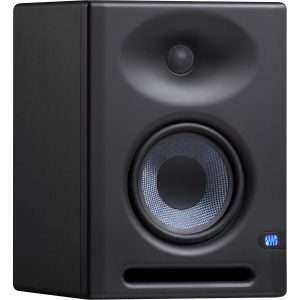M-Audio BX4 Active Studio Monitors (Pair)
Overview & Key Specs
-
Drivers: 4.5″ Kevlar woofer and 1″ silk-dome tweeter with a computer-optimized waveguide for accurate stereo imaging
-
Frequency Response: Approximately 69 Hz–22 kHz
-
Power: Total peak power of 120 W (2 × 25 W RMS per speaker)
-
EQ Controls: Rear-panel High‑EQ and Low‑EQ switches let you fine-tune sound to suit your room or positioning
₨ 75,000
The M-Audio BX4 is a pair of compact, active (powered) multimedia reference monitors, designed for a broader audience than just dedicated studio professionals. While they can be used for basic music production, they are particularly well-suited for content creators, gamers, and anyone looking for a significant audio upgrade from standard computer speakers.
There is also an M-Audio BX4 BT version which includes Bluetooth connectivity, offering even more versatility for wireless streaming. Unless specified as “BT,” the standard BX4 typically refers to the wired-only version.
Here’s a detailed look at the M-Audio BX4:
Key Features and Highlights:
- 4.5-inch Black Kevlar Low-Frequency Driver: Features a 4.5-inch woofer made of Kevlar. This material is chosen for its stiffness and damping properties, aiming for a tight and accurate bass response for its size.
- 1-inch Natural Silk Dome High-Frequency Driver: Equipped with a 1-inch silk dome tweeter, which is known for delivering smooth, clear, and non-fatiguing high frequencies.
- Active (Powered) Design: These are powered speakers, meaning the amplifiers are built into one of the speakers (the “active” one). The other speaker is “passive” and connects to the active speaker via a supplied 3.5mm TS interconnect cable.
- Total Power: 120 Watts peak power (2 x 25 Watts RMS). This is ample power for desktop listening and small rooms.
- Rear-Ported Cabinet: The cabinet features a rear-firing bass port. This design helps to extend the low-frequency response, providing more bass punch than sealed designs. The cabinet itself is made from acoustically inert MDF to reduce unwanted resonances.
- Computer-Optimized Tweeter Waveguide: A waveguide helps to control the dispersion of the high frequencies, contributing to improved stereo imaging and a wider listening sweet spot.
- Front-Panel Controls and Convenience: This is a major selling point for everyday use:
- Volume Knob/Power Switch: A combined volume control and on/off switch on the front for easy access.
- 1/8″ (3.5mm) Auxiliary Input: A convenient front-panel input for quickly connecting smartphones, tablets, or other portable audio devices. When this is used, it usually overrides other inputs.
- 1/8″ (3.5mm) Headphone Output: A front-panel headphone jack allows you to monitor your audio privately, automatically muting the speakers when headphones are plugged in.
- Rear-Panel Inputs:
- 1/4″ TRS Inputs (Left/Right): For connecting to audio interfaces, mixers, or other pro audio gear with balanced or unbalanced 1/4″ outputs.
- RCA Stereo Input Pair: For connecting to consumer audio equipment like turntables, CD players, or TVs.
- High-EQ and Low-EQ Controls: On the rear panel, there are knobs to adjust the high and low frequencies (typically +/-6 dB). These allow you to fine-tune the sound to your listening environment or personal preference, compensating for room acoustics or boosting bass/treble for casual listening.
- Left/Right Active Speaker Position Switch: A clever feature that lets you decide which speaker (the one with the volume knob and inputs) acts as the Left or Right channel. This is useful for cable management or if you prefer the controls on a specific side of your desk.
- Software Bundle: Often includes software like Pro Tools | First M-Audio Edition and MPC Beats, along with virtual instruments and effect plugins, adding value for aspiring producers.
- Included Accessories: Typically comes as a complete package, including the speakers, a 3.5mm TS interconnect cable (to connect the active to the passive speaker), a 3.5mm auxiliary cable, a 3.5mm to RCA cable, foam feet for isolation, and a power cable.
Who is the M-Audio BX4 for?
- Content Creators: Podcasters, YouTubers, streamers who need clear audio for editing and monitoring, and appreciate the front-panel controls and versatile inputs.
- Gamers: For a more immersive and detailed audio experience than standard PC speakers.
- Multimedia Users: Anyone looking to upgrade their audio for movies, online content, and general computer use.
- Beginning Home Studio Enthusiasts: For basic music production, beat-making, and demoing where space and budget are constraints.
- Users on a Tight Budget: They offer significant value for their price.
Considerations:
- “Reference” vs. “Critical Mixing”: While marketed as “studio monitors” and useful for mixing, it’s important to set expectations. At this price point and size, they provide a much more honest sound than consumer speakers, but they won’t offer the extreme flatness and detail required for highly critical, professional mixing and mastering. They might have a slightly “sweetened” sound compared to higher-end, truly flat monitors.
- Bass Extension: With a 4.5-inch woofer, the bass extends down to around 69 Hz. For genres with heavy sub-bass (e.g., electronic music, hip-hop), a subwoofer would be a necessary addition for accurate low-end monitoring.
- Rear-Ported Design: While beneficial for bass extension, placing them too close to a wall can cause bass buildup and muddiness. Some space behind them is generally recommended.
- Power Distribution: Since one speaker is active and powers the passive one, the interconnect cable between them is crucial.
- Bluetooth (Optional): Ensure you’re looking at the “BX4 BT” model if Bluetooth connectivity is a must-have feature for you. The standard BX4 does not have Bluetooth.
Based on 0 reviews
Be the first to review “M-Audio BX4 Active Studio Monitors (Pair)”
You must be logged in to post a review.












There are no reviews yet.